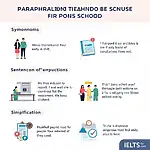As an experienced IELTS instructor, I understand the challenges that test-takers face when dealing with tricky instructions in the listening section. This crucial skill can make a significant difference in your overall performance. Let’s dive into the intricacies of handling complex directives and explore effective strategies to boost your IELTS listening score.
Understanding Tricky Instructions in IELTS Listening
Tricky instructions in IELTS listening often involve complex language, multiple steps, or conditional statements. These can be deliberately designed to test your ability to comprehend and follow detailed spoken English. Recognizing and effectively dealing with these instructions is key to succeeding in this part of the exam.
Common Types of Tricky Instructions
- Multi-step instructions
- Conditional statements
- Negatives and double negatives
- Time-sensitive directives
- Instructions with exceptions
Examples of Tricky Instructions in IELTS Listening
To better prepare you for the exam, let’s look at some examples of tricky instructions you might encounter:
- “Write no more than three words and/or a number for each answer.”
- “Choose the correct letter, A, B, or C, unless otherwise stated.”
- “Complete the sentences below. Write NO MORE THAN TWO WORDS for each answer.”
- “Listen to the recording and answer questions 1-5, but only if the information is explicitly stated.”
- “For questions 6-10, write one word only, except where a number is required.”
- “Select TWO letters, A-E, for each question, unless instructed otherwise.”
- “Fill in the blanks with the correct information. Use NO MORE THAN THREE WORDS AND/OR A NUMBER for each answer, ignoring articles.”
These examples demonstrate the variety and complexity of instructions you may face during the IELTS listening test.
Applying Knowledge to Real IELTS Exam Scenarios
Let’s explore how to apply this knowledge to actual IELTS listening tasks:
Scenario 1: Multiple Choice with a Twist
Instructions: “Choose TWO correct answers for each question. Write the appropriate letters, A-E, in the boxes provided.”
This instruction requires you to select multiple answers, a departure from the standard single-choice format. Pay close attention to the number of answers required and the range of options available.
Scenario 2: Conditional Completion Task
Instructions: “Complete the summary below. Use NO MORE THAN TWO WORDS from the passage for each answer. If a number is needed, write the number as a word.”
Here, you must adhere to the word limit, use words directly from the passage, and convert any numbers to words. This combination of requirements demands careful attention to detail.
Scenario 3: Map Labeling with Specific Conditions
Instructions: “Label the map below. Write the correct letter, A-H, next to questions 1-5. Use each letter only once. If a location is not mentioned, write ‘X’.”
This scenario combines map labeling with the need to identify unmentioned locations, adding an extra layer of complexity to the task.
Common Mistakes to Avoid
When dealing with tricky instructions, test-takers often fall into these pitfalls:
- Overlooking key words in the instructions
- Misinterpreting conditional statements
- Failing to adhere to word limits
- Ignoring specific formatting requirements (e.g., writing numbers as words)
- Not paying attention to exceptions or special cases mentioned
Effective Practice Techniques
To master the art of handling tricky instructions, consider these practice strategies:
-
Active Listening Exercises: Regularly practice with IELTS-style recordings, focusing on identifying and following complex instructions.
-
Instruction Breakdown: After each practice session, analyze the instructions. Break them down into smaller components and ensure you understand each part.
-
Timed Practice: Simulate exam conditions by giving yourself strict time limits when practicing. This helps improve your ability to process instructions quickly.
-
Varied Question Types: Expose yourself to a wide range of question formats and instruction styles to build flexibility and adaptability.
-
Peer Review: Practice with a study partner and review each other’s responses to instructions. This can help identify areas where misinterpretations occur.
 Effective IELTS Listening practice techniques
Effective IELTS Listening practice techniques
Conclusion
Mastering tricky instructions in IELTS listening is a skill that can significantly improve your test performance. By understanding common types of complex instructions, practicing with real exam scenarios, and avoiding common pitfalls, you can approach the listening section with confidence. Remember, the key lies in careful attention to detail and consistent practice. Keep refining your skills, and you’ll be well-prepared to tackle even the most challenging instructions on test day.
We’d love to hear about your experiences with tricky instructions in IELTS listening. Share your thoughts in the comments below, and don’t forget to explore our other IELTS preparation resources on IELTS.NET!


